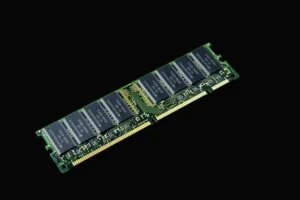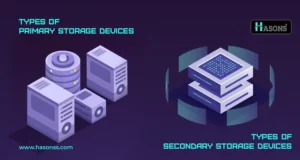Exploring Storage Devices: A Comprehensive Guide
Data storage is a crucial component of any computing system. As our reliance on digital information continues to grow, so too does our need for space to store that data. From smartphones to Supercomputers, all devices require some form of storage device.
Storage devices provide physical media to retain digital data utilizing recording techniques such as magnetism or optics. The data remains accessible even when the device is powered off. Storage capacity, speed, portability, and durability are key factors that determine the best storage solution for different applications.
In this blog post, we will explore the fundamentals of primary and secondary storage devices. We will also look at some emerging storage technologies that aim to meet the growing demand for digital storage space. By the end, you will have a solid understanding of the different types of storage devices, their capabilities, and use cases.
Understanding Primary Storage Devices
Primary storage, also known as main memory, refers to storage that is directly accessible to the CPU. It is used to store data that the computer is currently working with. Also Primary storage is much faster than secondary storage but offers limited capacity.
Primary Storage Devices Defined
Primary storage typically takes the form of Semiconductor memory, specifically in the form of random access memory (RAM). It is embedded on the motherboard and provides high-speed, temporary data access. Primary storage loses all data when power is turned off.
The main characteristics of primary storage include:
- Directly accessible by the CPU
- Volatile memory – Data is lost when power is removed
- Small storage capacity compared to secondary storage
- Very high performance and speed
Primary storage is a critical component in Computing systems, serving as the working memory where programs and data needed by the CPU are stored for fast access. Even the fastest processor would be ineffective without primary storage.
Now, understanding this concept is simple and entertaining for Hasons. Using the Hason website you can always stay one step ahead in your job, business, or studies by purchasing New Age Desktops and i3 Intel Core Processor Desktop starting from 15000/-. Monitors, CPUs, and Gaming Desktop are also available. Register on Hasons and order your Tech Partner Now. Get exciting offers and benefits on your every purchase. Contact us so our support team can guide you in purchasing the right Tech Partner.
Hasons ProSync NoHva
Hdmi Monitor 21.5-Inch” FHD (1920×1080) Display | Brightness: 250 Nits | VA Display 54.61 Cm (21.5 In) Widescreen Panel Active Area (W/H)67.60/26.70 Cm
Types of Primary Storage Devices
There are two main types of semiconductor memory used for primary storage:
1. Random Access Memory (RAM):
RAM allows data items to be read or written randomly, meaning any storage location can be accessed directly regardless of its physical placement. It is considered volatile memory since its contents are erased when power is removed.
 Several types of RAM used for primary storage:
Several types of RAM used for primary storage:
Static RAM (SRAM) – Made up of flip-flops that retain data bits. Faster than DRAM but more expensive. Used for cache memory.
Dynamic RAM (DRAM) – Stores each bit in a separate capacitor. Needs to be refreshed thousands of times per second. Most common and affordable type of RAM.
Synchronous DRAM (SDRAM) – Synchronizes itself with the CPU clock speed to improve performance.
2. Read-Only Memory (ROM):
ROM retain stored data even when power is remove, making it non-volatile memory. Data is permanently written during manufacturing and can not electrically erased or rewritten with the user.
Exploring Secondary Storage Devices
While primary storage offers vital temporary working space, secondary storage provides vast long-term storage capacity. Secondary garage keep record even if gadget power off.
Secondary Storage Defined
Also known as auxiliary storage or external storage, secondary storage is not directly accessible to the CPU. To access secondary storage, the data must first copy to primary storage before it can be processed.
Compared to volatile primary storage, secondary storage is non-volatile, meaning it retains data indefinitely even without power. It also offers much greater storage capacity to hold data and programs.
However, secondary storage is physically slower than primary storage. Data retrieval also write speed constrain with the mechanical motions of the storage medium. But affordability and massive storage capacity make secondary storage ideal for long-term data storage needs.

Types of Secondary Storage Devices
There are various types of secondary storage devices and technologies tailored to meet different performance, capacity, portability and cost requirements. Let’s look at some of the most common options:
1. Hard Disk Drives (HDD
Hard Disk Drives have dominated as the primary non-volatile storage device for computers and consumer electronics. The Hard disks use magnetic recording heads to read/write data onto quickly rotating magnetic platters.

Key features:
- Non-volatile storage
- High capacity of up to 10+ TB
- Moderate cost per megabyte
- Moderately high data transfer rates
- Moving mechanical parts prone to failure
- Not portable
HDDs are challenged through solid-state drives in many applications but remain highly prevalent in desktop PCs, servers, also Network-attached storage devices.
2. Solid-State Drives (SSD)
SSDs are a newer type of storage device that uses integrated circuits to store data persistently. NAND-based flash memory most commonly use in Solid State Drives.
Key advantages of SSDs:
- Faster read/write speeds than HDDs
- Noiseless with no moving parts
- Lower access latency
- More resistant to physical shock
- Smaller and lighter than HDDs
- Higher cost per gigabyte of storage
SSDs are standard in smartphones and laptops. Their speed and durability also make them desirable for high-performance computing applications.
3. External Hard Drives
External hard drives contain HDDs or SSDs in a portable enclosure. They connect to computers via USB, Firewire, esata, also wirelessly.
Benefits of external hard drives:
- Easily add extra storage capacity
- Portable for transferring large data
- Provide backup storage for personal data
- Offer a range of capacities from 500GB to 10TB+
- Limitations include slower speeds and higher cost compared to internal drives. Overall, external hard drives
- provide a practical way to expand storage for desktops, laptops, game consoles, media centers, also more.
Emerging Storage Technologies
Continued growth in data volumes also the need for faster data access is driving new innovations in storage technology. Let’s look at some emerging storage approaches.
1. Cloud Storage
Cloud storage allows users to save data remotely to an off-site storage system accessed over the internet. Leading providers include Amazon S3, Microsoft Azure, also Google Cloud.
Advantages of cloud storage:
- Access files from any device with an internet connection
- No need to purchase additional local storage
- Automatic backups ensure data recovery
- Scales easily as per usage needs
- Managed by the service provider
However, bandwidth limitations can impact performance. There are also privacy concerns over storing data externally on third-party servers.
2. Network-Attached Storage (NAS)
NAS systems provide centralized file-level storage that will access by authorized devices over a local area network or WAN. NAS appliances work as dedicated file servers with their own network address.
Benefits of NAS include:
- More economical than SAN technology
- Provides shared storage for many users
- Easy to add capacity
- Integrates with existing networks
- Can replicate data to remote servers
- NAS systems are a popular choice for SMBs to meet enterprise-level storage needs cost-effectively.
3. Solid-State Drives (SSDs)
As mentioned earlier, SSD adoption is accelerating thanks to benefits like faster read/write speeds, lower latency, ruggedness, and low power usage. Innovations in NAND flash technology along with declining costs will solidify SSDs as the future of computer storage.

NVMe (Non-Volatile Memory Express) SSDs attached directly to the PCIe bus take storage speeds to new levels also 3D NAND technology stacks flash memory cells vertically to deliver terabyte-level capacities. Storage manufacturers are also transitioning from SATA to NVMe and PCIe 4 interfaces to unleash SSD performance.
The Future of Data Storage
Data storage needs are growing exponentially. New technologies on the horizon aim to push storage capabilities even further.
1. Quantum Storage
Quantum storage utilizes quantum physics phenomena to store data in isolated quantum systems. It promises ultra-high density thanks to the ability to represent data in multiple states at once through superposition. Data retrieval is near-instantaneous.
2. DNA Storage
DNA data storage encodes and retrieves data in synthetic DNA strands. Its high density, durability, and longevity hold great promise for mass archival storage applications. While current costs are prohibitive, technological advances may soon make DNA data storage commercially viable on a large scale.
Researchers have encoded over 200 MB of data into DNA strands. While DNA-based memory and storage could someday replace traditional media for archiving huge amounts of data over centuries.
Characteristics of Computer Storage Devices
- Data Capacity: The amount of data a storage device can hold, typically measured in bytes (e.g., gigabytes, terabytes).
- Access Time: The time it takes to retrieve data from the storage device.
- Transfer Rate: The speed at which data can be read or written to the storage device.
- Durability: The ability of the storage device to withstand physical stress and environmental factors.
- Portability: The ease with which a storage device can be moved or transported.
Brief History of Storage Devices
The evolution of storage devices has been closely tied to the development of computing technology. Early storage devices included punch cards, magnetic drums, and magnetic tapes. HDDs were introduced in the 1950s and became the primary storage device for computers for several decades. Optical discs (CDs and DVDs) emerged in the 1980s and 1990s, respectively. Flash-based storage devices, such as USB drives and SSDs, gained popularity in the late 20th and early 21st centuries.
Why is storage needed in a computer?
Storage devices are crucial in computers for the following reasons:
- Application Storage: Programs and applications are stored on storage devices for installation and execution.
- Data Storage: User data, such as documents, images, videos, and other files, are stored on storage devices for future access and retrieval.
- Backup and Recovery: Storage devices are used to create backup copies of important data, enabling recovery in case of data loss or system failure.
The future of data storage
As technology advances, new storage technologies are being developed to meet the ever-increasing demand for higher capacities, faster speeds, and improved durability. Some emerging storage technologies include:
- Non-Volatile Memory Express (NVMe): A high-speed interface designed for SSDs, offering improved performance over traditional storage interfaces.
- 3D XPoint Memory: A non-volatile memory technology that combines the speed of DRAM with the non-volatility of flash memory.
- DNA Data Storage: An experimental technology that uses synthetic DNA as a high-density, long-lasting storage medium.
- Holographic Data Storage: A potential future storage technology that uses lasers and photosensitive materials to store data in three dimensions, offering extremely high capacities.
Operating System Storage: The operating system, which manages the computer’s resources and provides a platform for running applications, is stored on a storage device.
Conclusion
Storage Devices form the backbone of computing systems and digital data management. While Primary storage offers vital temporary working space for high-speed data access. Secondary storage provides vast long-term storage capacity.
HDDs and SSDs currently dominate as primary secondary storage options. Each has relative strengths and weaknesses. Emerging technologies like cloud storage, NAS systems, also faster SSDs aim to meet growing enterprise and consumer storage needs. Exciting innovations on the horizon such as quantum and DNA storage may unlock almost unfathomable data densities.
| If you are reading Storage Device then also check our other blogs | |
| Super Computer kya hai | Power Electronic Pioneers |
| Wireless Network | Types of Internet Connection |
Storage Device
- What is a computer storage device?A computer storage device is a hardware component used to store data, programs, and information in a computer or computing system. It provides a permanent or semi-permanent place to store digital data, even when the power is turned off.
- 2. What are examples of Optical storage devices?Examples of optical storage devices include CDs (Compact Discs), DVDs (Digital Versatile Discs), and Blu-ray discs. These devices use laser technology to read and write data on a plastic disc coated with a reflective material.
- Is online cloud storage a device?No, online cloud storage is not a physical device. It refers to a network-based storage service where data is stored on remote servers accessed over the internet. While cloud storage relies on physical storage devices in data centers, from the user's perspective, it is a service rather than a local device.

